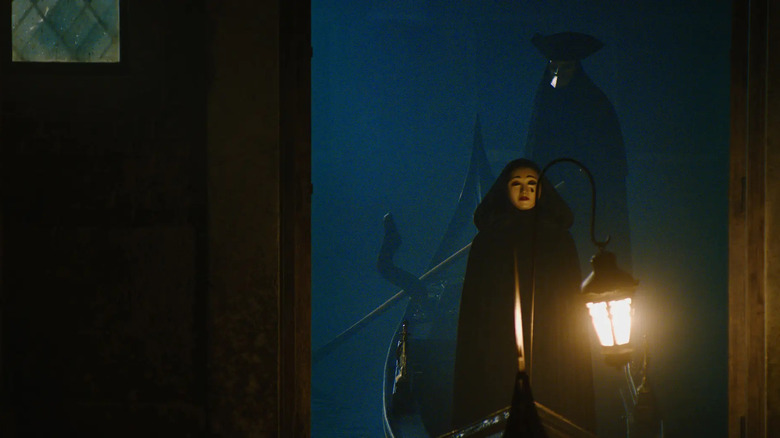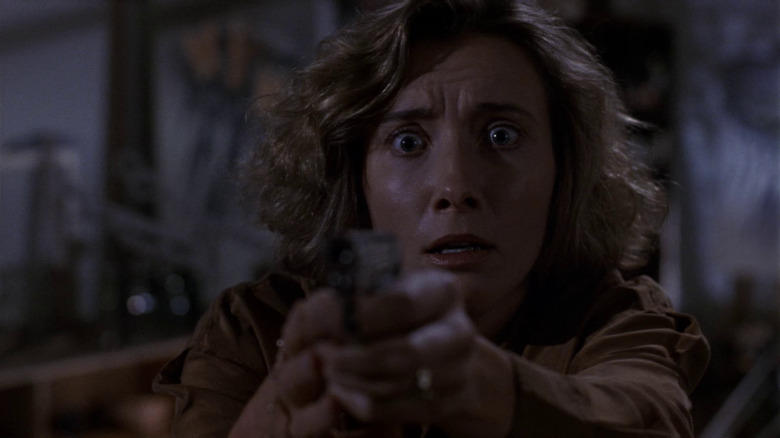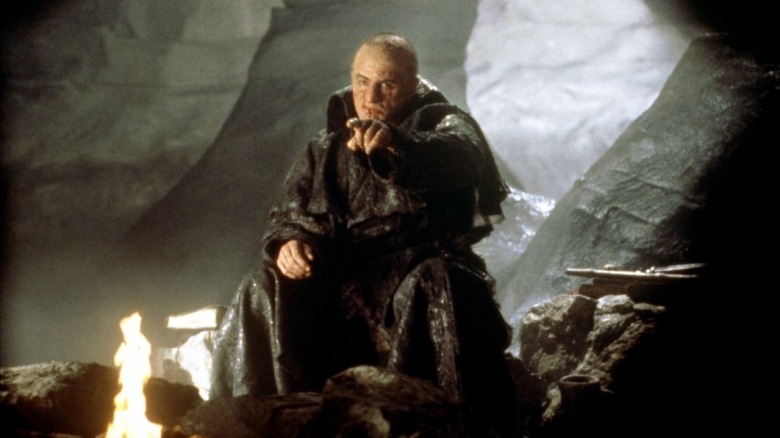A Haunting In Venice Isn't Kenneth Branagh's First Horror Movie
Kenneth Branagh's newest film, "A Haunting in Venice" is his spookiest to date. Based on the 1969 novel "Hallowe'en Party," "Haunting" sees Hercule Poirot (Branagh) hauled out of retirement by a mystery author named Ariadne Oliver (Tina Fey) to investigate the veracity of an itinerant psychic named Joyce Reynolds (Michelle Yeoh). Joyce Reynolds has been hired by a wealthy Venitian socialite named Rowena Drake (Kelly Reilly) to attend a Halloween party for children and, once the lights are out, host a séance. Poirot and Ariadne don't believe Joyce has authentic psychic powers, but can't prove she doesn't.
There are about seven other main characters, each with a mystery or a personal tragedy of their own.
The bulk of "A Haunting in Venice" takes place in Rowena Drake's labyrinthine, shadowy Venetian manse, with Poirot exploring its many secret passageways and darkened corridors. As this is a murder mystery, one of the film's many characters will be killed (natch), and it will be up to Poirot to find the killer before the sun rises. Also ... was that a ghost? Creepy things are afoot. As a director, Branagh infused "Haunting" with an appropriately Halloween-ish tone, including a lot of tarot-like imagery, flashing lightning, eerie unknowable groaning sounds, and multiple scary Italian masks. Branagh, it seems, is very good at creating a horror movie atmosphere.
And, of course, this was hardly the first time the director made such an achievement. After Branagh exploded onto the cinematic scene in 1989 with his cinematic adaptation of William Shakespeare's "Henry V," he followed it with a high-profile studio thriller called "Dead Again," a twisty, dark, and excellent murder mystery that involves intergenerational murder and past-life regression.
And, yes, I will go to bat for 1994's "Mary Shelley's Frankenstein."
Dead Again is great
Branagh was proving his chops as a genre filmmaker very early in his career, as "Dead Again" is not merely excellent, but could be one of the best films of 1991. It contains stabbings, revenge, infidelity, jealousy, and a delicious element of the supernatural. Branagh stars as a not-well-respected private investigator named Mike Church who takes in a mysterious mute woman (Emma Thompson) with amnesia. While Mike Church is investigating the mute woman's identity — he has named her Grace — they are visited by a pleasant hypnotist named Franklyn (Derek Jacobi). Franklyn hypnotizes "Grace," and she regresses into what might be a past life ... perhaps as the victim of a notorious 1948 murder. In the 1948 story — filmed in beautiful black-and-white — Branagh plays a composer named Roman Strauss who was executed for murdering his wife Margaret, played by Thompson.
"Dead Again" is savvy and brilliant about constructing two mysteries at the same time. While Grace's identity is uncovered, so too is the 1948 scandal that led to the death of Margaret Strauss. And, yes, it seems that we, in our current incarnations, may be susceptible to the actions of our previous incarnations. The script by Scott Frank ("Out of Sight") is twisted and tantalizing.
"Dead Again" was a shock to fans of Branagh's "Henry V," who might have assumed the young Irish actor was only capable of theatrical language and classical theater. It seems that Branagh could construct a potboiler as well as anyone, taking advantage of the medium with the verve of someone just discovering cinema. He also, perhaps naturally, works well with actors, getting great performances from Thompson, Jacobi, and Robin Williams as a bitter, foul-mouthed former psychiatrist who now works in a grocery store.
Frankenstein is good, actually
And, of course, Branagh scooped up all his habits for overwrought theatricality and all-celebrity casts and made his own version of "Frankenstein" in 1994. At the time, "Mary Shelley's Frankenstein" was lambasted by critics and audiences for deviating from Shelley's original novel, and for being far too melodramatic to be scary or effective. Given the number of unfaithful "Frankenstein" movies that have been made in the last century of cinema, deviating from the source material is hardly a cardinal sin. And Branagh created a "Frankenstein" that was hyperactive, goopy, chaotic, and dead sexy; there is a literal bodice-ripping scene.
A broad, noisy, theatrical version of "Frankenstein" is no bad thing, and Branagh found the right balance of chaos and calm. Branagh played Dr. Frankenstein and was careful to give himself a sexy long hairdo and to show off his toned torso as often as he could. His would-be paramour was played by Helena Bonham Carter, and the film also starred Tom Hulce, John Cleese (!), and Ian Holm. The human scenes are all noisy, full of laughter when life is good ... and screams of horror when there is death. And there's a lot of death.
When the film finally meets the Creature, everything quiets down. The Creature, played soulfully by Robert De Niro, wanders into the countryside, his body cross-crossed by scars, wondering what humanity is and if he has a soul. The music stops, and the editing slows. The Creature scenes are oddly placid. When he finally confronts Dr. Frankenstein, one can understand his existential crisis ... and his untapped rage. The Creature knows beauty, but also a horrific wrath.
Branagh clearly knows terror and gore and ghosts as well as he knows the Bard or superheroes. He's a good horror filmmaker.


